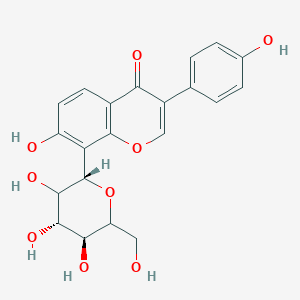| MeSH term | MeSH ID | Detail |
|---|---|---|
| Alcohol-Related Disorders | D019973 | 3 associated lipids |
| Lead Poisoning | D007855 | 4 associated lipids |
| Urinary Incontinence | D014549 | 4 associated lipids |
| Hepatitis, Alcoholic | D006519 | 5 associated lipids |
| Dyspepsia | D004415 | 5 associated lipids |
| Hypertension, Renovascular | D006978 | 10 associated lipids |
| Amnesia | D000647 | 12 associated lipids |
| Glucose Intolerance | D018149 | 13 associated lipids |
| Angina, Unstable | D000789 | 14 associated lipids |
| Brain Infarction | D020520 | 17 associated lipids |
SCHEMBL105486
Kakonein is a lipid of Polyketides (PK) class. Kakonein is associated with abnormalities such as Fatty Liver, Chronic liver disease, Morphologically altered structure, Hypertensive disease and Cardiovascular Diseases. The involved functions are known as protein expression, Extravasation, Liver damage, mRNA Expression and cell activation. Kakonein often locates in Body tissue, Hepatic, Microvilli, Cytoplasm and Membrane. The associated genes with Kakonein are TJP1 gene, CD14 gene, iberiotoxin, AT-Rich Interactive Domain-Containing Protein 1A and NKS1 gene. The related lipids are dehydrosoyasaponin I and Steroids. The related experimental models are Knock-out.
Cross Reference
Introduction
To understand associated biological information of SCHEMBL105486, we collected biological information of abnormalities, associated pathways, cellular/molecular locations, biological functions, related genes/proteins, lipids and common seen animal/experimental models with organized paragraphs from literatures.
What diseases are associated with SCHEMBL105486?
SCHEMBL105486 is suspected in Chronic liver disease, Hypertensive disease, Cardiovascular Diseases, Myocardial Infarction, Cerebrovascular accident, Fatty Liver and other diseases in descending order of the highest number of associated sentences.
Related references are mostly published in these journals:
| Disease | Cross reference | Weighted score | Related literature |
|---|
Possible diseases from mapped MeSH terms on references
We collected disease MeSH terms mapped to the references associated with SCHEMBL105486
PubChem Associated disorders and diseases
What pathways are associated with SCHEMBL105486
There are no associated biomedical information in the current reference collection.
PubChem Biomolecular Interactions and Pathways
Link to PubChem Biomolecular Interactions and PathwaysWhat cellular locations are associated with SCHEMBL105486?
Visualization in cellular structure
Associated locations are in red color. Not associated locations are in black.
Related references are published most in these journals:
| Location | Cross reference | Weighted score | Related literatures |
|---|
What functions are associated with SCHEMBL105486?
Related references are published most in these journals:
| Function | Cross reference | Weighted score | Related literatures |
|---|
What lipids are associated with SCHEMBL105486?
Related references are published most in these journals:
| Lipid concept | Cross reference | Weighted score | Related literatures |
|---|
What genes are associated with SCHEMBL105486?
Related references are published most in these journals:
| Gene | Cross reference | Weighted score | Related literatures |
|---|
What common seen animal models are associated with SCHEMBL105486?
Knock-out
Knock-out are used in the study 'MATE2 mediates vacuolar sequestration of flavonoid glycosides and glycoside malonates in Medicago truncatula.' (Zhao J et al., 2011).
Related references are published most in these journals:
| Model | Cross reference | Weighted score | Related literatures |
|---|
NCBI Entrez Crosslinks
All references with SCHEMBL105486
Download all related citations| Authors | Title | Published | Journal | PubMed Link |
|---|---|---|---|---|
| Mo SF et al. | Hypouricemic action of selected flavonoids in mice: structure-activity relationships. | 2007 | Biol. Pharm. Bull. | pmid:17666819 |
| Zhang Y et al. | Puerarin Prevents LPS-Induced Osteoclast Formation and Bone Loss via Inhibition of Akt Activation. | 2016 | Biol. Pharm. Bull. | pmid:27904045 |
| Yao WJ et al. | Effect of poly(amidoamine) dendrimers on corneal penetration of puerarin. | 2010 | Biol. Pharm. Bull. | pmid:20686234 |
| Zhang S et al. | Puerarin induces angiogenesis in myocardium of rat with myocardial infarction. | 2006 | Biol. Pharm. Bull. | pmid:16651724 |
| Jin JS et al. | Biotransformation of C-glucosylisoflavone puerarin to estrogenic (3S)-equol in co-culture of two human intestinal bacteria. | 2008 | Biol. Pharm. Bull. | pmid:18670101 |
| Nakamura K et al. | Enzymatic cleavage of the C-glucosidic bond of puerarin by three proteins, Mn(2+), and oxidized form of nicotinamide adenine dinucleotide. | 2013 | Biol. Pharm. Bull. | pmid:23328408 |
| Zhao LX et al. | The permeability of puerarin loaded poly(butylcyanoacrylate) nanoparticles coated with polysorbate 80 on the blood-brain barrier and its protective effect against cerebral ischemia/reperfusion injury. | 2013 | Biol. Pharm. Bull. | pmid:23902970 |
| Yue PF et al. | The study to reduce the hemolysis side effect of puerarin by a submicron emulsion delivery system. | 2008 | Biol. Pharm. Bull. | pmid:18175940 |
| Choo MK et al. | Antithrombotic and antiallergic activities of daidzein, a metabolite of puerarin and daidzin produced by human intestinal microflora. | 2002 | Biol. Pharm. Bull. | pmid:12392089 |
| Bao L et al. | The anti-atherosclerotic effects of puerarin on induced-atherosclerosis in rabbits. | 2015 | Biomed Pap Med Fac Univ Palacky Olomouc Czech Repub | pmid:24510110 |
